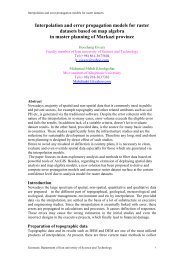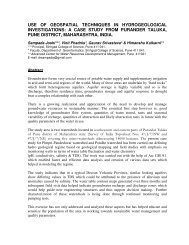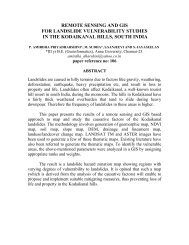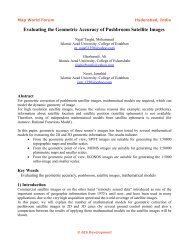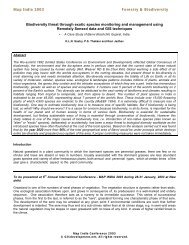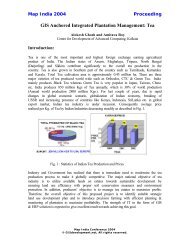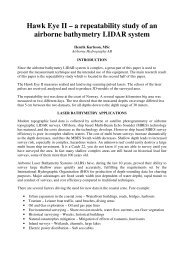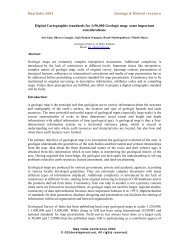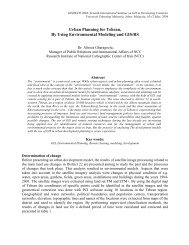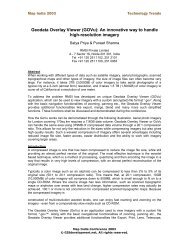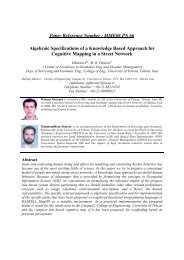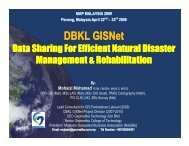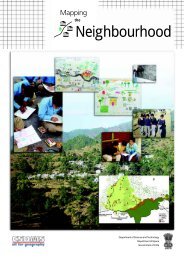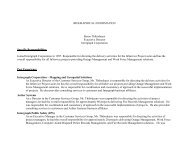Map India 2005 Geomatics 2005
Map India 2005 Geomatics 2005
Map India 2005 Geomatics 2005
You also want an ePaper? Increase the reach of your titles
YUMPU automatically turns print PDFs into web optimized ePapers that Google loves.
<strong>Map</strong> <strong>India</strong> <strong>2005</strong> <strong>Geomatics</strong> <strong>2005</strong><br />
Exploitation of Corundum at Lakshmipuram, Khammam District<br />
Andhra Pradesh, <strong>India</strong>.<br />
Narayan Sangam & Pavanaguru, R.<br />
Dept. of Geology, Osmania University, Hyderabad-500 007<br />
Narayan_sangam@rediffmail.com,pavanaguru@rediffmail.com<br />
Keywords: Lakshmipuram, Khammam Schist Belt, Mineral Resource, Corundum<br />
Exploitation ,Mineralisation, Remote-sensing studies&GIS<br />
Abstract<br />
Mineral corundum, an oxide of alumina of semi-precious nature is occurring in the<br />
vicinity of Lakshmipuram area, Khammam District, Andhra Pradesh.Corundum, in<br />
particular, apart from other minerals, is being extensively exploited by the local people<br />
without having any proper knowledge of its parent/source rock.<br />
In the past as well as the present day, the local people have employed the pits<br />
and trenching method of corundum exploitation wherein, the mineral corundum is being<br />
transported from the upper reaches (Hills of Gobbagurti) and gets concentrated in these<br />
pits and trenches, mostly along the nalah cuttings and lower reaches of the stream<br />
network. Crystals of Corundum are being collected soon after the rains by means of<br />
panning the soil cover.<br />
The present research paper is an attempt towards understanding the<br />
Petrogenesis of Corundum and its controls of Mineralisation using the Techniques of<br />
Remote sensing and GIS.<br />
Introduction:<br />
Khammam district, of Andhra Pradesh is known for its occurrences of precious<br />
and semi-precious mineral resources in commercial quantities(Corundum&Garnet)<br />
Corundum in the form of ruby, light pink or red, and ordinary corundum variety is<br />
occurring in Lakshmipuram area, which is included in the Konijerla mandal of Khammam<br />
district. The area is located about 12 kms. east of Khammam town and is quite<br />
accessible .<br />
© <strong>Map</strong> <strong>India</strong> <strong>2005</strong>
The haphazard exploitation activity of corundum by the local entrepreneurs along<br />
certain faiths and beliefs, is going on in this area over a considerable period of time. The<br />
state authorities have investigated these areas where exploitation has been done and<br />
reported in their annual technical reports (DMG 2001-2002). Some of the previous<br />
contributions from the geologists who have studied this area, which is a part of<br />
Khammam Schist Belt, on the geology and petrogenetic evolution as it occupies pivotal<br />
position among the various litho units of the schist belts in the eastern Dharwar craton<br />
include (Balakrishna & Subbaraju (1976), Sarvothaman H. (2001), Leelanandam &<br />
Narsimha reddy (1985), Ramakrishnan.M etal (1998), Ramam&Murthy (1997). The<br />
geology of corundum occurrences have been a subject of considerable economic<br />
importance and many workers in recent times have contributed on this subject<br />
(Chandrasekhar, H and Nazeer Ahmed (1994), Devaraju, T.K. and Alikhan, M.A., (1981),<br />
Gandhi Prasad et.al. (1984), Panjikar et.al (1985), Rama Rao B. (1962), Ravindra<br />
et.al.(1990) Viswanatha M.N. (1972), Dayasankar et al.(2001) Narayan Sangam(2002)<br />
Narayan Sangam & Pavanaguru(2002). Narayan Sangam(2004)<br />
The area of investigation poses several complexities with respect to its geology,<br />
structure and tectonics in view of the nature and controls of corundum mineralisation. As<br />
no comprehensive work on with regards to its petrogenesis and mineralisation has been<br />
done in the past, systematic investigations were attempted using the techniques of<br />
Remote sensing and GIS. Integrated remote sensing methods, incorporating distinct<br />
themes have been emphasized to facilitate the identification of zones of mineralisation of<br />
corundum in this area.<br />
Data Used:<br />
Remote sensing studies using IRS 1C/1D LISS III Geocoded FCC image dated<br />
Feb. 99 has been utilized and interpreted and different overlays of information<br />
concerning geology, structure, geomorphology, drainage has been synthesized to arrive<br />
at a meaningful solutions. SOI Toposheets(65c/7&65c/8) and Geological map(GSI) were<br />
also utilized for this study.<br />
Geology of the area<br />
The Lakshmipuram area is a part of the Khammam schist belt. It is situated along<br />
the northern continuity of the Nellore schist belt, south of river Godavari. The Geological<br />
2
formations of the area is comprised of Amphibolites, Biote-granite gneisses, Schists of<br />
various types, which are intruded at places by the quartzo-felspathic mobilisates in the<br />
form of Pegmatites. These rock types are sporadically exposed as most of the area is<br />
covered by soil cover. The Nagarjunasagar Left Canal excavations through this area<br />
exposed many salient geological features of great importance.<br />
Stratigraphic succession of the area<br />
Era<br />
Recent<br />
Precambrian<br />
Lithology<br />
Soil cover with colluvium and alluvium<br />
Quart veins<br />
Pegmatites<br />
Aplites<br />
Quartzofespathic rock (Granite)<br />
Charnockite<br />
Metadolerite<br />
Schists—Sillimanite-Quartz-Chlorite-Hornblende-Biotite,<br />
Garnetiferous schists<br />
Amphibolite<br />
Peninsular Granite-gneissic complex<br />
Structure:<br />
NW-SE trending cratonic fold occupying a major fracture developed internal to<br />
the axis of the Chimalpahad Anorthosite Gabbro Complex (CAGC) The general strike of<br />
the foliations in the schists of various types varies from N 30 0 W to S 30 0 E to N 50 0 W<br />
to S 50 0 E with varying dips towards east. Predominant shear joints parallel to major<br />
shear zones (interpreted from satellite imagery) along N 10 0 W and N-S are observed<br />
where outcrops are exposed and exhibit with almost vertical dips. The foliation trends<br />
and the shear planes can be correlated with the well preserved transpressional shears<br />
observed in the), described by Leelanandam et al.(2002). With the available satellite and<br />
field data of joint patterns and foliation trends a structural map of the area has been<br />
prepared (Fig 3). Felsic rocks such as Granite, Aplites and pegmatite. Number of quartz<br />
veins has emplaced the planes of schistosity in amphibolites and the associated shear<br />
3
fractures. Three sets of joints are common: N 45 0 E to S 45 0 W/70 deg vertical, N 10 0 W<br />
to S 10 0 E /vertical and N 45 0 W to S 45 0 E/vertical<br />
Mode of occurrence of Corundum<br />
The mode of occurrence of Corundum (all varieties) in Gubbagurti area is in the<br />
form of float, insitu and placers. Float deposits are observed in close proximity to the<br />
primary occurrence and is mixed with soil cover or weathered zones of the rock or in the<br />
colluvium mixed with quartz and it is very difficult to observe unless the eyes are properly<br />
trained.<br />
Insitu occurrence of corundum is noticed in association with felspathic rocks and<br />
pegmatite emplaced into the structural planes of amphibolites. The contact between<br />
felspathic rock and the garnetiferous amphibolites forms major insitu occurrence. The<br />
dug material shows the presence of weathered pegmatite associated with amphibolite.<br />
Petrographically corundum with lamellar twinning is associated with coarse grain<br />
felspathic rock.<br />
Placer concentrations are exploited along the Nalla courses. Expansive panning<br />
of alluvium is observed and the recoveries are also encouraging particularly during rainy<br />
season. It is vividly observed along the culverts where prospecting pits by the locals<br />
amply justify the transportation of corundum from the upper reaches of the stream<br />
system. The significant feature of corundum occurrence is along the structural trends,<br />
which control the drainage pattern, and where colluvium is extensively associated with<br />
pebbles of quartz. Placer accumulations with thickness of about 10 Cm. lying below a<br />
thick soil cover of about 1m. spread over a large aerial extent is under active<br />
exploitation.<br />
Exploitation and Extraction of Corundum:<br />
Corundum pieces are collected soon after the rains generally at the periphery of<br />
the basic rocks as pyroxene granulites, amphibolites and schists. The detrital corundum<br />
4
occurs as ill defined crystals of 0.25 to 0.5*1.0 cm in size but well developed prismatic<br />
crystals as big as 2cm*4cm are not uncommon. Corundum is invariably present where<br />
the soil is underlain by brownish granule zone consisting of very small fragments of<br />
sillimanite, ferruginous matter and quartz in a matrix of brown soil. The thickness varies<br />
from 0.15 to 0.30m.<br />
Lakshmipuram Area:<br />
The incidence of corundum is spread over 50 hectares of the area which<br />
is under cultivation. Old pits and dumps south of Lakshmipuram village comprise<br />
decomposed basic rocks, white mica and acicular sillimanite. Trenches expose biotite<br />
gneisses, amphibolites, quartz-sillimanite gneisses and mica schists wherein light pink<br />
,translucent variety is found to occur. One trench exposed sillimanite schists, sillimanite<br />
corundum, bounded by biotite gneisses. Corundum is reported to occur in association<br />
with the sillimanite bearing schists which are intruded at places by quartzo felspathic<br />
pegmatites.<br />
The sillimanite horizon starts at 2.20m and continues upto 4.90m in depth.Here,<br />
translucent to semitransparent variety of light to dark purple coloured corundum is found<br />
to occur.(0.5 to 1cm) in size.Insitu corundum is reported to occur at 1.50m depth.<br />
Geomorphology:<br />
The area possesses dendritic to sub-dendritic drainage. Majority of the<br />
streams drain into NW-SE and N-S trending major streams and enter into the pediment<br />
area and finally discharge into Wyra lake. They lose their velocity as they approach the<br />
lower reaches and thus helps in continuous deposition of their content in the meanders<br />
and confluence points of different nallas. They carry along with them rich colluvial<br />
corundum and all the culverts are the focal points for placer accumulations which are<br />
actively exploited in this area. The geomorphic units comprise of Denudational hills,<br />
Residual hills, Structural hills, Pediment zones, Pediplain shallows and Valley fills.<br />
Discussion and conclusions<br />
Corundum occurrences in and around Gobbagurti area consist of Singaraipalem,<br />
Ratnapuram, Lakshmipuram, Nallagutta and Tummalepalle villages of Konijerla mandal.<br />
If the entire cratonic zone is studied in detail, major amounts of Corundum, Ruby and<br />
Garnet minerals can be explored in million tonnes. Sillimanite and Sericite bearing<br />
5
schists are occasionally observed in close proximity with the mineralisation. The<br />
petrographic studies of the host rocks clearly indicate the occurrence of corundum with<br />
quartzo felspathic rocks. However, corundum is not found with in amphibolitesCorundum<br />
is observed in colluvium particularly along the meander points of the drainage pattern in<br />
the Lakshmipuram area forms both float and placer concentrations. In addition to the<br />
micro level geological exploration, petrology, mineralogy and geochemistry can give rise<br />
to invaluable information on Corundum, Ruby and Garnet minerals.<br />
As there is no direct evidence as to the source rock for corundum in the area, it<br />
could be presumed that corundum could have formed due to the desilication of quartz<br />
and alumina rich rocks traversed by ultrabasic/ultramafic rocks.<br />
From the studies it is concluded that:<br />
1. Precious and semi precious variety corundum is significantly<br />
mineralised in Lakshmipuram area and also concealed under soil<br />
cover.<br />
2. Lithology, structure and geomorphology controls and concentrate<br />
mineralisation.<br />
3. Remote sensing studies facilitated to delineate the favourable<br />
extended zones of mineralisation.<br />
4. To explore full potential of mineralisation and the nature of<br />
intrusives and their metamorphic history it is imperative to initiate<br />
a detailed petrological and structural investigations<br />
5. A comprehensive geoscientific evaluation is a necessity to<br />
identify the richness of the deposits.<br />
Acknowledgements<br />
The authors thank Dr. V. Diwakar Rao and Dr. M.N. Reddy of geology Dept.<br />
Osmania University for their useful discussions during the preparation of this paper. The<br />
help and cooperation received from Dr. K. Paninder Rao of State Ground water<br />
department and Sri Narahari of Geological survey of <strong>India</strong>, Hyderabad is gratefully<br />
acknowledged.<br />
:<br />
References:<br />
6
Balakrishna and Subbaraju, P. 1976 Geology of Khammam dt. With spl. Reference to<br />
Bethampudi area. Unpublished Geological Survey of <strong>India</strong> report.<br />
Dayasankar, Rajagopal Reddy and Satyanarayana 2001 Corundum occurrences in<br />
parts of Khammam district, A.P. DMG Technical Report, Govt. of A.P.<br />
Devaraju,T.K. and Alikhan, M.A. 1981 Gemstones and their occurrence with special<br />
reference to corundum and its varieties in Karnataka. Mysore Minerals Ltd.<br />
Bangalore<br />
Gandhi Prasad, T.K., Nagaraja Rao, K.N., Murthy, SRN and Viswanatha, M.N. 1084<br />
Preliminary investigation for precious and semi precious stones in Southern<br />
Karnataka. Unpublished report, Geological survey of <strong>India</strong>.<br />
Leelanandam C and Narasimha Reddy M 1985 Petrology of Chimalpahad anorthosite<br />
complex, Andhra Pradesh, <strong>India</strong>. Neues Jb. Miner. Abh. 153 pp. 91-119<br />
Narayana Sangam & Pavanaguru 2002. Geoscientific evaluation of corundum in and<br />
around Konijerla mandal, Khammam dt. A.P. Proceedings of the National<br />
Seminar on GIS in geosciences, Dec. 2002, Hyderabad.<br />
Panjikar, Jayashree, Charasekar, H., Muniswamiah, M. and Nazeer Ahmed 1984 A<br />
study of gem varieties of corumdum from parts of Tumkur and Mysore<br />
districts, Karnataka. Jour. Geol. Soc. <strong>India</strong>. V 43, pp-311-315<br />
Rama Rao, B. 1962 An outline of mineral resources of Mysore DMG bull. No. 22<br />
Ravindra, B.M. Krishna Rao, B. and Vasudev, V.N. 1990 Ore petrological aspects of<br />
copper Mineralisation near Kayadi, Hasan district Karnataka. Jour. Geol.<br />
Soc. <strong>India</strong> v35 pp 159-172<br />
Viswanatha M.N. 1972 Corumdum-pegmatitie and corundum sillimanite-pegmatite from<br />
Kalyadi area, Hasan district, Mysore state. <strong>India</strong>n minerals v 27 pp. 20-23.<br />
Ramakrishnan M, Nanda J.K. and Augustine P.F. 1998 Geological evolution of<br />
proterozoic Eastern Ghat mobile Belt. G.S.I. spl. Pub. No. 44 pp 1-21.<br />
Ramam P.K. and Murthy, V.N. 1997 Geology of Andhra Pradesh, Geological Society of<br />
<strong>India</strong> pp 1-245.<br />
Sarvothaman H. 2001 Archaean high Mg granitoids of Mantle origin in eastern Dharwar<br />
Craton in Andhra Pradesh. J. Geolo. Soc. <strong>India</strong>. 58 pp. 261-268.<br />
7



